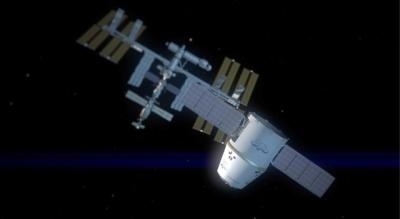Thu, May 24, 2012
Fifteen Experiments Focusing On Physical, Chemical, And Biological Systems
The SpaceX Dragon capsule, which on Tuesday became the first commercially developed and built spacecraft to launch to the International Space Station, is carrying among its cargo a suite of 15 science experiments designed by students.

Known collectively as Aquarius, the experiments will assess the effects of microgravity on physical, chemical and biological systems. The students have been immersed in every facet of research, from definition of the investigation to experiment design, proposal writing and a formal NASA proposal review for selection of flight experiments. "This unique student activity adds a new dimension to the International Space Station and its role as America's only orbiting national laboratory," said Leland Melvin, NASA's associate administrator for Education. "It also clearly demonstrates that students still can actively participate in NASA microgravity opportunities in the post-shuttle era."
Aquarius is sponsored by the Student Space Flight Experiments Program (SSEP), which is a cooperative venture by the National Center for Earth and Space Science Education (NCESSE) and NanoRacks LLC, a national science, technology, engineering and mathematics (STEM) education initiative. The organizations work together to give 300 to 1,000 students across a community the opportunity to design and propose microgravity experiments to fly in low Earth orbit.
The first two SSEP payloads flew in 2011 aboard space shuttles Endeavour and Atlantis on the STS-134 and STS-135 missions respectively. This third round of experiments will be the first to be conducted in orbit by space station astronauts. The announcement of opportunity for Aquarius was released in July 2011. It elicited responses from 12 communities in nine states and the District of Columbia. A total of 779 student teams, with 41,200 members ranging from fifth graders to community college, submitted proposals. After a formal two-step review process in fall 2011, the final 15 flight experiments were selected. They all passed a formal NASA flight safety review, clearing the final hurdle on their journey to launch.
This is one of many programs that use NASA's science and exploration missions to encourage students to pursue a STEM-centric school curriculum. Building a robust cadre of scientists and engineers for the future is a high priority for NASA's Office of Education. (Images provided by SpaceX)

More News
Light Gun A handheld directional light signaling device which emits a brilliant narrow beam of white, green, or red light as selected by the tower controller. The color and type of>[...]
"The journey to this achievement started nearly a decade ago when a freshly commissioned Gentry, driven by a fascination with new technologies and a desire to contribute significan>[...]
Aero Linx: JAARS, Inc. For decades now, we’ve landed planes on narrow rivers and towering mountains. We’ve outfitted boats and vehicles to reach villages that rarely se>[...]
"Our driven and innovative team of military and civilian Airmen delivers combat power daily, ensuring our nation is ready today and tomorrow." Source: General Duke Richardson, AFMC>[...]
Aircraft Conflict Predicted conflict, within EDST of two aircraft, or between aircraft and airspace. A Red alert is used for conflicts when the predicted minimum separation is 5 na>[...]
 ANN's Daily Aero-Term (04.20.24): Light Gun
ANN's Daily Aero-Term (04.20.24): Light Gun Aero-News: Quote of the Day (04.20.24)
Aero-News: Quote of the Day (04.20.24) ANN's Daily Aero-Linx (04.21.24)
ANN's Daily Aero-Linx (04.21.24) Aero-News: Quote of the Day (04.21.24)
Aero-News: Quote of the Day (04.21.24) ANN's Daily Aero-Term (04.21.24): Aircraft Conflict
ANN's Daily Aero-Term (04.21.24): Aircraft Conflict




